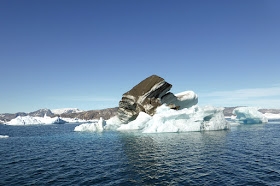It's a long, cold zodiac ride from base camp past Tiniteqilâq (Tinit) and across the Sermilik fjord,
so we were grateful for our Mustang survival suits. On the way we had occasions to photograph each other,
and our progress through the fjord.
The zodiac created a strong breeze, so at times I needed to turn away from the bow and face downwind to thaw out.
Here's my "zodiac clip".
We all went crazy admiring the zoo of shapes, colors, and shadows sculpted by wind, water, and sun.
And by glacial droppings.
Large bergs can split off from glaciers feeding the fjord, or be driven into the fjord from the North Atlantic.
The clear ice in this pair had been under such compression, such weight of ice in the past that all the air had been squeezed out of it.
On reaching the far side of Sermilik, at the mouth of Johan Petersen, we stopped for a restroom break.
Then our intrepid zodiac drivers ferried us on to the island known to the Greenlanders as "Bad Island," because in earlier days it was impossible to reach due to icebergs.
There we gladly shed our Mustangs and divided into two groups; one for an easy walk and one to hike to the top of the island.
Joan and I joined Drew's group, headed for the summit.
The island (Ingmíkêrfíkajik on the map) has no paths, but plenty of shelves and ways to climb from one to the next.
Embedded mica (the blown-out white spots in the photo) was common in the rocks. Click on the image to enlarge, as usual.
Drew pointed out various botanical features, arctic plants that survive by clinging to the ground. I even tasted crowberries. We were thrilled to get a quick glimpse of a gyrfalcon, which Drew spotted zipping over us. The raptor flew so fast that even if my camera had been out and on, I couldn't have captured a photo.
The broad top of the island is spectacularly placed.
Looking across at the Brückner Glacier.
Zooming in on the ice there.
Looking at the glaciers at the head of the fjord.
Too soon it was time to start back down.
The landing zone is in sight. Here we would spread out and enjoy a generous picnic lunch, including hot soup. On these outings the NatHab team kept us well fed, including pick-me-up snacks between meals.
We hadn't finished exploring. After lunch our zodiacs headed towards the head of the fjord and the Kagtilersorpia glacier, with its ice tongues and waterfalls.
Every one of us was having a great time.
Joan and I were in Julius' zodiac. Julius was born and raised in Tinit, but took advantage of Greenlanders status as Danish citizens and attended university in Copenhagen. (Although attending the university was free, room and board was not.) He put us to shame by being trilingual in English, Danish, and Greenlandic.
We admired layered strata and intruding flows exposed by glacial scouring.
Julius returned from a scouting expedition on the right bank. It looked good to forge ahead.
A couple of the waterfalls were new this year, according to Julius.
Katie, our bold mountain goat of a guide, went ashore at the waterfall at the tip-end of the fjord. Look for the little red jacket on the rocks just left of the bottom!
We were truly lucky. Ours was only the second NatHab group to make it all the way to the end of Johan Petersen; the others were deterred either by ice blockades or terrible weather.
In fact, the conditions were so good that our zodiac fleet took a new route back via Ikâsak Stoklund fjord, known as the "iceberg graveyard." From the map it's clear that any iceberg that squeezes through the tight gaps into that fjord will have a difficult time squeezing back out.
The icebergs came in complex shapes and sizes. It's a good thing we had digital and not film cameras ... so many pictures to take!
Now how do you suppose this one got created? It looks gritty/dusty on top.Here, part of a berg split off, and with its center of gravity shifted, the berg's old waterline is now exposed at a 40º angle.
We had one rest break on the long journey back. Some of us accumulated back or bottom fatigue spending so long in the zodiacs, but it was well worth it.
And needless to say, we devoured the savory dinner back at base camp.
































No comments:
Post a Comment
Comments may not appear immediately as they are moderated by the author to eliminate spam. Please, no commercial links!